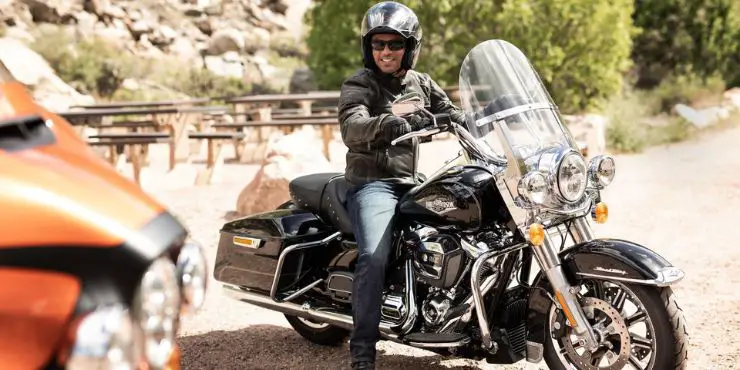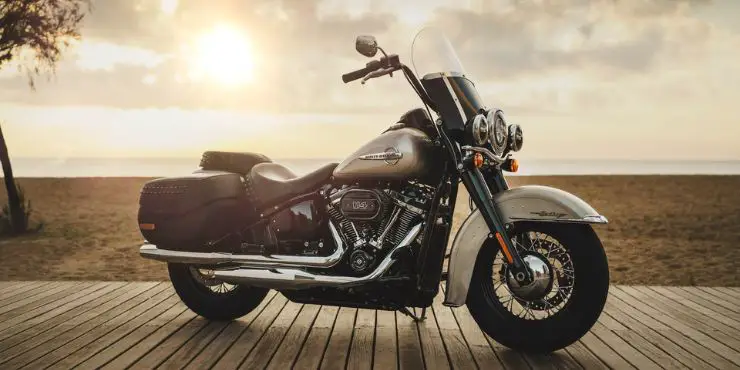Do you own a Road King and feel intrigued to know the year when the fuel injection system was added? If so, then you’re certainly in the right place.
Harley-Davidson introduced fuel injection on the Road King in 1996 as an option, and by 2007, fuel injection became standard on most models.
In this guide, you’ll get to know all about the Harley-Davidson Road King, the fuel injection factor in Road King, what year did Harley start fuel injection on Road King, the basics of the fuel injection system, how does EFI work, and is EFI better than the carburetor system among others. Stick around to know all the answers that you’re looking for.
What year did Harley start fuel injection on Road King?
Harley-Davidson released the iconic FLHR Harley-Davidson Road King in 1994. The original Road King replaced the FLHS Electra Glide Sport. The FLHR Road King used to be powered by Harley-Davidson’s 1,340cc evolution v-twin engine. It featured a whole host of upgrades over the Electra Glide that it was replacing. Some of them were improved wiring harness with waterproof connectors, taller gear ratios, and improved wiring harness. The other features included dual front disc brakes, air-adjustable forks, and a passenger seat that you could easily remove. The Harley-Davidson Road King got positioned as a combination touring and cruiser machine.
In 1996, Harley-Davidson came out with the FLHR and FLHRI models. The “I” in the latter indicated the Harley-Davidson Road King with fuel injection. The Weber Marelli fuel-injection system allowed Harley-Davidson to pass California’s emission system without adding a catalyst converter to its bikes. This resulted in better fuel mileage as an added benefit.
The Harley-Davidson Road King has completed over 25 years of production. As with most Harley models, the Road King also remains largely the same as it was initially introduced. The Harley-Davidson Road King is widely used in police and fire departments in not just America, but in other countries too.

The basics of a fuel injection system
An EFI or Electronic Fuel Injection system is essentially a computer-controlled fuel delivery system. The Electronic Control Unit (ECU) reads different sensors located on the vehicle. This makes the determination of how much fuel is to be allowed in the engine. The system opens and closes the injectors, which allow the gasoline into the engine based on the fuel map and sensor inputs programmed into the computer. The different sensors (engine temperature, RPM, throttle position, air temperature, manifold pressure) offers information on operating conditions and engine load.
The Weber-Marelli system was used on Harley-Davidson Road King, while the Magneti-Marelli system was used on EVO and Twin Cam engines until 2001. There were also the Buell XL engines that had an Alpha-N EFI system. On these motorcycles, load sensing gets determined by the throttle position. The new Delphi EFI system used on the latest Twin Cam engines is a Speed Density system. It determines the engine load depending upon the intake manifold system.
How does an EFI system work?
The computer will determine the current RPM of the Road King’s engine based on the input signals coming from the Crank Position Sensor. The computer will then determine the load on the engine as it checks the MAP sensor or Throttle Position Sensor.
The computer will take the RPM and Engine Load info to the Fuel Map located in the ECU. Say if the computer isn’t able to find the exact matches to the RPMs and Engine Load. It’ll then estimate the required value by looking at the values slightly higher and lower for calculating the needed value. For instance, if your bike’s engine is running at Wide-Open Throttle at 3,900 RPMs, it’ll calculate the fuel value as 44, which is half the way between 33 and 55.
Now that the computer has the right fuel value, it has to determine if any adjustments to the fuel map value are necessary. The computer will determine the engine temperature. In case the engine is cold, the fuel number will be adjusted by a pre-determined percentage.
For instance, if the engine temperature is a 30°F, the computer will know that the engine is cold and requires more fuel, similar to a choke on a carburetor. The computer will look up an engine adjustment percentage of 20%. If the previously looked-up value was 44, the computer will add 20% to that number, giving you 53. As the engine is warming up, the adjustment percentage becomes smaller and at normal operating temperatures, the value becomes zero.
The computer will determine the ambient temperature of the air entering the intake via the Intake Air Temperature sensor. Similar to the engine temperature adjustment, the computer looks up the percentage adjustment. Now return to the full throttle acceleration of 3900 RPMs and assume that the engine has warmed up to normal operating temperature.
However, the outside air temperature is around 90°F. The computer will look up the adjustment percentage of -2%. The computer knows that at high air temperatures, the engine needs less fuel. This is why it reduces the value from 44 to 43. If the air temperature was cold, the fuel mixture would have been made a bit richer.
The computer has determined that at the Wide Open Throttle of 3900 RPMs, a normal engine temperature, and 90° air entering the intake, the engine has to keep each fuel injector open 43% of the time. The computer will then check to see if it’s time for the fuel injector to get activated.
Once it’s time for the fuel injector to open, the computer will then allow the current to flow through the injector for the needed amount of time. The opening time can be easily controlled accurately and precisely, right down to the millisecond.
Is an EFI system better than a carburetor system?
Choosing a carburetor and tuning it is more often than not a series of compromises. A carburetor is essentially a demand device dependent on the velocity of the air entering the venturi for creating the air/fuel mixture that is feeding the engine. A carb helps in maintaining a series of fuel circuits to maintain the best possible fuel mixture. The idle circuit, main, and intermediate jetting circuits are used for tuning the mixture across the operating RPM range of the engine.
The different fuel circuits interact with each other to create rich, lean spots in the fuel curve. Some riders go as far as to add lean spots in the fuel curve. Some riders can also go as far as to add additional fuel circuits in an effort to improve the fuel curve. The interactions of additional circuits complicate the tuning efforts. A change in jetting to the fuel circuit impacts the required jetting in another circuit.
You can simplify things by assuming a carburetor with nothing more than the main circuit and an idle circuit. For optimizing low RPM performance, a small diameter carburetor will offer the best performance. However, at high RPMs, a large volume of air will be required for feeding the engine. It requires a comparatively larger diameter carburetor. The carb’s ability to provide a decent air/fuel mixture depends on the velocity of air going through the carb.
The signal needs to be present for maintaining a good throttle response. If the diameter of the carb is too large for the engine, you can expect low RPM performance. Most Harley-Davidson mechanics and riders are aware that having a large carburetor syndrome results in a poor running engine. This situation doesn’t really occur with an Electronic Fuel Injection engine.
With an EFI system, the needed fuel amount for each RPM and engine load condition will be located on the fuel map in the ECU. Once you know the primary fuel amount, the ECU will further adjust the fuel mixture for the engine and air intake temperature.
In the majority of the most cases, the mixture can be adjusted for altitude and barometric pressure. Based on different sensor inputs to EFI ECU, there’s only one fuel value that gets generated. The correct fuel mixture will be fed into the engine all the time. As the airflow doesn’t have to pass through a venturi to offer an air/fuel mixture, the throttle plate diameter could be pretty large. It allows the engine to draw in all the air that it wants. As more air equates to higher horsepower potential, all that the EFI needs to do is offer the correct amount of fuel for the increase in airflow.
Conclusion
Thank you for reading. Hopefully, now you know a lot more about the Harley-Davidson Road King, the fuel injection factor in Road King, what year did Harley start fuel injection on Road King, the basics of the fuel injection system, how does EFI work, and is EFI better than the carburetor system among others. The fuel injection system on Harley-Davidson Road King was started back in 1996.
The original FLHR Road King used to be powered by a 1,340cc Evolution V-twin engine, but in 1996, Harley-Davidson introduced the Road King with both the FLHR and FLHRI variants. The “I” in the latter indicated the Harley-Davidson Road King with fuel injection.

